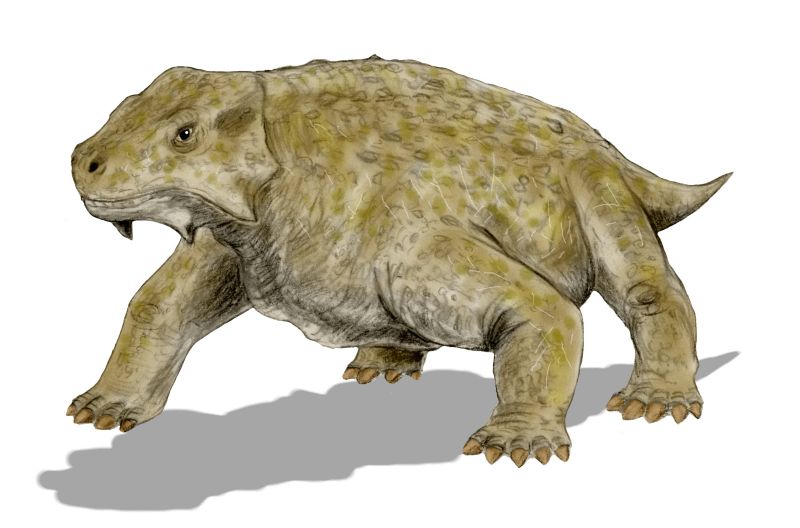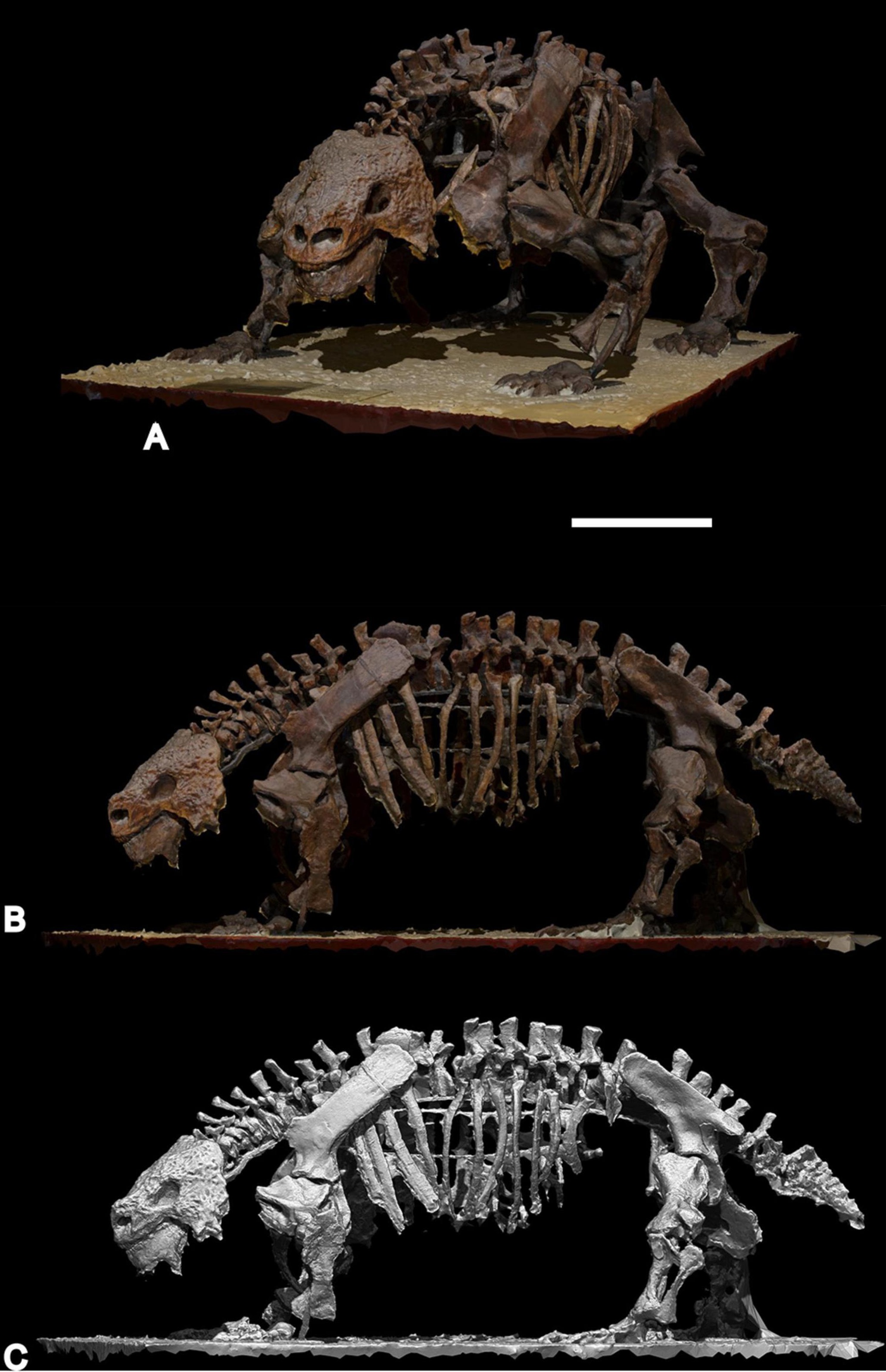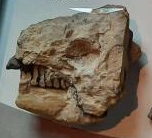|
Pareiasaur
Pareiasaurs (meaning "cheek lizards") are an extinct clade of large, herbivorous parareptiles. Members of the group were armoured with osteoderms which covered large areas of the body. They first appeared in southern Pangea during the Middle Permian, before becoming globally distributed during the Late Permian. Pareiasaurs were the largest reptiles of the Permian, some reaching sizes over , equivalent to the largest contemporary therapsids. Pareiasaurs became extinct in the end-Permian mass extinction event. Description Pareiasaurs ranged in size from long, with some species estimated to exceed in body mass. The limbs of many parieasaurs were extremely robust, likely to account for the increased stress on their limbs caused by their typically sprawling posture. The cow-sized '' Bunostegos'' differed from other pareiasaurs by having a more upright limb posture, being amongst the first amniotes to develop this trait. Pareiasaurs were protected by bony scutes called osteoderms ... [...More Info...] [...Related Items...] OR: [Wikipedia] [Google] [Baidu] |
Elginia
''Elginia'' is an extinct genus of pareiasaurid known from the Late Permian of Scotland and China. It was named for the area around Elgin, Moray, Elgin in Scotland, which has yielded many fossils referred to as the Elgin Reptiles. Discovery The type species of ''Elginia, Elginia mirabilis,'' was first described in 1893 by Edwin Tulley Newton, E.T. Newton, after fellow geologists John Horne and Archibald Geikie informed him of several unusual specimens stored at the Elgin Museum (Moray), Elgin Museum in Scotland. The specimens were collected several years earlier from the coarse sandstones of the nearby Cutties Hillock Quarry. The quarry’s sandstone, the Cutties Hillock Sandstone Formation, is often (but not always) considered equivalent to the otherwise fossil-poor Hopeman Sandstone Formation of broader Scottish geology. Tetrapod remains occupy a narrow section of the sandstone, lying above a pebbly layer. The sandstones of Cutties Hillock were deposited at the very end of ... [...More Info...] [...Related Items...] OR: [Wikipedia] [Google] [Baidu] |
Bunostegos
''Bunostegos'' ("knobbly kullroof") is an extinct genus of pareiasaur parareptile from the Late Permian of the Agadez Region in Niger. The type species, ''Bunostegos akokanensis'', was named from the Moradi Formation in 2003. It was a cow-sized animal with a distinctive skull that had large bony knobs, similar in form to those of other pareiasaurs but far larger. The species appears to have lived in a desert in the centre of the supercontinent of Pangaea. Analysis of the limb bones (including the scapulocoracoid, humerus, Radius (bone), radius, ulna, pelvis, and femur) was published in 2015, and revealed that ''Bunostegos'' walked upright on four limbs, with the body held above ground. This new information directly suggests that it could be the first tetrapod with a fully erect gait. Description The animal has been described as about the size of a modern cow with a knobbly skull and bony plate armor on its back." Its teeth show it to have been a plant eater. It lived in an isol ... [...More Info...] [...Related Items...] OR: [Wikipedia] [Google] [Baidu] |
Scutosaurus
''Scutosaurus'' ("shield lizard") is an extinct genus of pareiasaur parareptiles. Its genus name refers to large plates of armor scattered across its body. It was a large anapsid reptile that, unlike most reptiles, held its legs underneath its body to support its great weight. Fossils have been found in the Sokolki Assemblage Zone of the Malokinelskaya Formation in European Russia, close to the Ural Mountains, dating to the late Permian (Lopingian) between 264 and 252 million years ago. Research history The first fossils were uncovered by Russian paleontologist Vladimir Prokhorovich Amalitskii while documenting plant and animal species in the Upper Permian sediments in the Northern Dvina River, Arkhangelsk Oblast, Arkhangelsk District, Northern European Russia. Amalitskii had discovered the site in 1899, and he and his wife Anne Amalitskii continued to oversee excavation until 1914, recovering numerous nearly complete and articulated (in their natural position) skeletons belon ... [...More Info...] [...Related Items...] OR: [Wikipedia] [Google] [Baidu] |
Yinshanosaurus
''Yinshanosaurus'' is an extinct genus of pareiasaurian parareptiles from the Late Permian Naobaogou Formation of China. The genus contains a single species, ''Yinshanosaurus angustus'', known from a partial skeleton including a skull and an additional isolated skull. Discovery and naming The ''Yinshanosaurus'' holotype specimen, IVPP V 33181, was collected in 2018 from outcrops of the Naobaogou Formation near Qiandian Village in Inner Mongolia, China. It consists of a partial articulated skeleton, including a skull, both scapulocoracoids, the third–fifth cervical (neck) vertebrae, thirteen dorsal (back) vertebrae and three isolated dorsal neural spines, several ribs, and the acetabular part of the left ilium. Several osteoderms are preserved in association with the vertebral column. The skull is eroded and crushed but otherwise nearly complete. An additional nearly complete skull, SXNHM V0010.12, was collected in 2015 from the Sunjiagou Formation of Shanxi, China. ... [...More Info...] [...Related Items...] OR: [Wikipedia] [Google] [Baidu] |
Pumiliopareia
''Pumiliopareia'' is an extinct genus of pareiasaurid parareptile from the Permian period of South Africa. It is known from a complete skeleton with osteoderms. Description ''Pumiliopareia'' was about 50 cm (19.6 in) in length with a 12 cm (4.7 in) skull. It is the smallest known member of the pareiasaurs, measuring only a fifth as long as some of its larger relatives. Like '' Anthodon'', its body was entirely covered with osteoderms. In analyses that support a pareiasaur origin of turtles, the sister taxon of the testudines. However it specifically shares with turtles a single trait only: Ribs greatly expanded anteroposteriorly (i.e. wide). Classification Originally included under the genus '' Nanoparia'', it was given its own name by Lee 1997 who found it did not form a clade with ''Nanoparia luckhoffi'', the type species of that genus, and preferred to have monophyletic genera. ''Nanoparia'' may still be a paraphyletic Paraphyly is a taxonomic term describing ... [...More Info...] [...Related Items...] OR: [Wikipedia] [Google] [Baidu] |
Anthodon (reptile)
''Anthodon'' (meaning "flower tooth") is an extinct genus of pareiasaur parareptile from the Permian period of South Africa and Tanzania. History In 1845, amateur geologists William Guybon Atherstone and Andrew Geddes Bain discovered several fossils near Dassieklip, Cape Province, in the Bushman's River Valley. This was the first dinosaur find in Africa and in the Southern Hemisphere. In 1849 and 1853, Bain sent some of the fossils to palaeontologist Richard Owen for identification. Among them was an upper jaw Bain referred to as the "Cape ''Iguanodon''", so the site was named "Iguanodonhoek". Atherstone published a short paper about the discovery in 1857,Atherstone, W.G. (1857). "Geology of Uitenhage". ''The Eastern Province Monthly Magazine''. 1 (10): 518–532. but lamented in 1871 that it had thus far received no attention in London. In 1876 Owen named a series of specimens from the collection ''Anthodon serrarius'', basing the generic name on the resemblance of the teeth ... [...More Info...] [...Related Items...] OR: [Wikipedia] [Google] [Baidu] |
Huanghesaurus
''Shihtienfenia'' is an extinct genus of pareiasaurid parareptile from the Late Permian of China. Species Lee (1997) refers to ''S. xuecunensis'' as a metaspecies lacking the autapomorphies of ''Shihtienfenia''. Tsuji & Müller (2009) seem to consider it a valid taxon for cladistic analysis, and like Lee 1997 place the two Chinese species close to '' Pareiasuchus''. ''S. permica'' (Young and Yeh, 1963); The skull of this pareiasaur is unknown. It is known originally from a number of isolated vertebrae, jaws, and limb-bones and an incomplete skeleton, all from the Shiqianfeng locality near Baode, Shanxi Shanxi; Chinese postal romanization, formerly romanised as Shansi is a Provinces of China, province in North China. Its capital and largest city of the province is Taiyuan, while its next most populated prefecture-level cities are Changzhi a ..., part of the Sunjiagou Formation. ''Shanshisaurus xuecunensis'' Cheng, 1980 and ''Huanghesaurus liuliensis'' Gao, 1983 are syn ... [...More Info...] [...Related Items...] OR: [Wikipedia] [Google] [Baidu] |
Sanchuansaurus
''Sanchuansaurus'' is an extinct genus of pareiasaur from the late Permian Sunjiagou Formation of China. The genus contains a single species, ''S. pygmaeus'', known from a partial maxilla and left leg bones. A 2013 study suggested that both ''Sanchuansaurus'' and another Chinese pareiasaur, ''Huanghesaurus'', were synonymous with ''Shansisaurus''. However, this has not been followed in future research, with later papers considering ''Sanchuansaurus'' to be distinct, with ''Huanghesaurus'' and ''Shansisaurus'' possibly being synonymous with ''Shihtienfenia ''Shihtienfenia'' is an extinct genus of pareiasaurid parareptile from the Late Permian of China. Species Lee (1997) refers to ''S. xuecunensis'' as a metaspecies lacking the autapomorphies of ''Shihtienfenia''. Tsuji & Müller (2009) seem to ...'', another Chinese pareiasaur. References {{Taxonbar, from=Q124059882 Pareiasauria Permian China Prehistoric animals of China Permian reptiles of Asia Prehistoric re ... [...More Info...] [...Related Items...] OR: [Wikipedia] [Google] [Baidu] |
Provelosaurus
''Provelosaurus'' is an extinct Pareiasaur genus of the Late Permian found on the road between Aceguá and Bagé in the Paleorrota, Rio Grande do Sul, Brazil. Found in the Rio do Rasto Formation, aged about 260 million years.http://www.ufrgs.br/geociencias/paleo/pareiassauro2.html Museu da UFRGS The holotype specimen found measures in length.Juan C. Cisneros, Paula Dentzien-Dias and Heitor Francischini. 2021. "The Brazilian Pareiasaur Revisited". ''Frontiers in Ecology and Evolution'' Classification Originally described as a South American representative of the genus ''Pareiasaurus ''Pareiasaurus'' (from , "cheek" and , "lizard") is an extinct genus of Pareiasauromorpha, pareiasauromorph reptile from the Permian period. It was a typical member of its family (biology), family, the pareiasaurids, which take their name from th ...'', it was assigned to a new genus ''Provelosaurus'' by Lee (1997), who noted it shows more affinities with the small, highly derived, South Africa ... [...More Info...] [...Related Items...] OR: [Wikipedia] [Google] [Baidu] |




